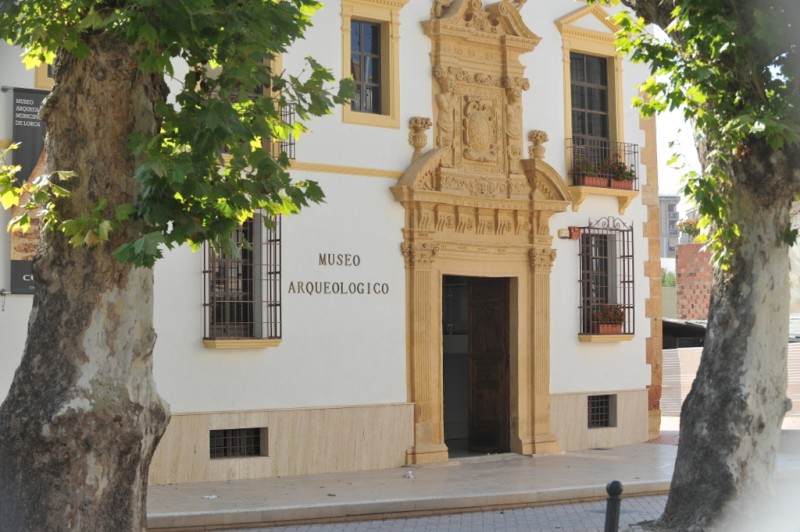- Region
- Águilas
- Alhama de Murcia
- Jumilla
- Lorca
- Los Alcázares
- Mazarrón
- San Javier
-
ALL AREAS & TOWNS
- AREAS
- SOUTH WEST
- MAR MENOR
- MURCIA CITY & CENTRAL
- NORTH & NORTH WEST
- TOWNS
- Abanilla
- Abarán
- Aguilas
- Alamillo
- Alcantarilla
- Aledo
- Alhama de Murcia
- Archena
- Balsicas
- Blanca
- Bolnuevo
- Bullas
- Cañadas del Romero
- Cabo de Palos
- Calasparra
- Camping Bolnuevo
- Campo De Ricote
- Camposol
- Canada De La Lena
- Caravaca de la Cruz
- Cartagena
- Cehegin
- Ceuti
- Cieza
- Condado de Alhama
- Corvera
- Costa Cálida
- Cuevas De Almanzora
- Cuevas de Reyllo
- El Carmoli
- El Mojon
- El Molino (Puerto Lumbreras)
- El Pareton / Cantareros
- El Raso
- El Valle Golf Resort
- Fortuna
- Fuente Alamo
- Hacienda del Alamo Golf Resort
- Hacienda Riquelme Golf Resort
- Isla Plana
- Islas Menores & Mar de Cristal
- Jumilla
- La Azohia
- La Charca
- La Manga Club
- La Manga del Mar Menor
- La Pinilla
- La Puebla
- La Torre
- La Torre Golf Resort
- La Unión
- Las Palas
- Las Ramblas
- Las Ramblas Golf
- Las Torres de Cotillas
- Leiva
- Librilla
- Lo Pagan
- Lo Santiago
- Lorca
- Lorquí
- Los Alcázares
- Los Balcones
- Los Belones
- Los Canovas
- Los Nietos
- Los Perez (Tallante)
- Los Urrutias
- Los Ventorrillos
- Mar De Cristal
- Mar Menor
- Mar Menor Golf Resort
- Mazarrón
- Mazarrón Country Club
- Molina de Segura
- Moratalla
- Mula
- Murcia City
- Murcia Property
- Pareton
- Peraleja Golf Resort
- Perin
- Pilar de la Horadada
- Pinar de Campoverde
- Pinoso
- Playa Honda
- Playa Honda / Playa Paraíso
- Pliego
- Portmán
- Pozo Estrecho
- Puerto de Mazarrón
- Puerto Lumbreras
- Puntas De Calnegre
- Region of Murcia
- Ricote
- Roda Golf Resort
- Roldan
- Roldan and Lo Ferro
- San Javier
- San Pedro del Pinatar
- Santiago de la Ribera
- Sierra Espuña
- Sucina
- Tallante
- Terrazas de la Torre Golf Resort
- Torre Pacheco
- Totana
- What's On Weekly Bulletin
- Yecla


- EDITIONS:
 Spanish News Today
Spanish News Today
 Alicante Today
Alicante Today
 Andalucia Today
Andalucia Today
The archaeological museum in Lorca
The oldest cloth in Europe and a journey through the history of Lorca from pre-history until the 15th century
By no means every town or city in Spain has enough archaeological wealth to boast its own museum, but in the case of Lorca the sites which are dotted around the huge municipality have provided so many items of interest dating from pre-history to the Middle Ages that the impressive facility housed in the Casa de los Salazar Rosso almost seems too small to show them all off.
The museum contains a series of extremely well presented displays, with most of the exhibits housed in earthquake-proof glass cabinets which were installed following extensive damage to the building as a result of the earthquakes which hit the city of Lorca on 11th May 2011. During the reconstruction the display rooms were thoroughly re-designed, and the result is one of the best museums of its kind in the Region of Murcia: it may not be the biggest, but great thought has gone into layout and presentation, and the variety of exhibits makes a visit an informative and highly enjoyable experience.
Arguably the highlight among the items on display is a case containing fragments of woven cloth dating from over 2,200 years before Christ. This is the oldest manmade fabric yet found in Europe.
But this is only one exhibit among hundreds, and as well as the Argaric and Iberian cultures of prehistoric south-eastern Spain there are also plenty of items dating from the times of the Romans, the Moorish occupation and the Reconquista by Christian forces in the medieval period. Another of the highlights belongs to this last section, and consists of fine and delicate glassware created by the Jewish community of Lorca as long ago as the fifteenth century.
Before visiting the museum, visitors with an interest in history may find it beneficial to read the history of Lorca which helps to put the exhibits within the musuem into context. The history has been split into three sections:
For pre-history in Lorca, Iberians and Argarics, see the first part of this series of articles outlining the history of Lorca.
The next stage in the history of Lorca is covered by Part 2, which traces the story from the arrival of the Romans in the last centuries BC to the occupation by the Moors.
Part 3 focuses on the "Modern era" in Lorca, from the Reconquist to the present
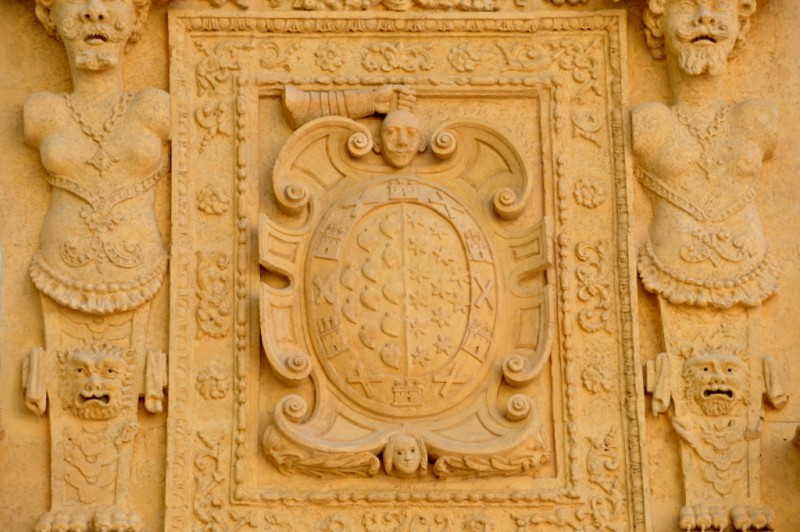
The home of the Archaeological Museum of Lorca
Since 1992 Lorca’s archaeological museum has been located inside the Casa de los Salazar Rosso, a former palatial residence in the Plaza de Juan Moreno alongside Calle Santo Domingo. This is one of a large number of aristocratic homes which were built between the 16th and 19th centuries in Lorca, and which contributed to the city becoming known as the “Ciudad de los Cien Escudo” (the city of 100 coats of arms).
The Salazar and Rosso families were wealthy merchants from Genoa who had set up home (and business) in Lorca, and the magnificent stonework on the façade reflects the splendour of their lifestyle. The most impressive element is the elaborate doorway, which includes the family coat of arms and two sphinxes with the faces of bearded men, the busts of women and the lower limbs of lions.
After it was built by the Salazar Rosso family the building was also occupied by other illustrious names, including the Marqués de Esquilache and the Moreno Rocafull family, before it came into the hands of the Town Hall.
The palace was built in the late 16th and early 17th centuries, although in the last twenty-five years it has been fully restored twice: once prior to the opening of the museum, and again following the earthquakes of 2011.
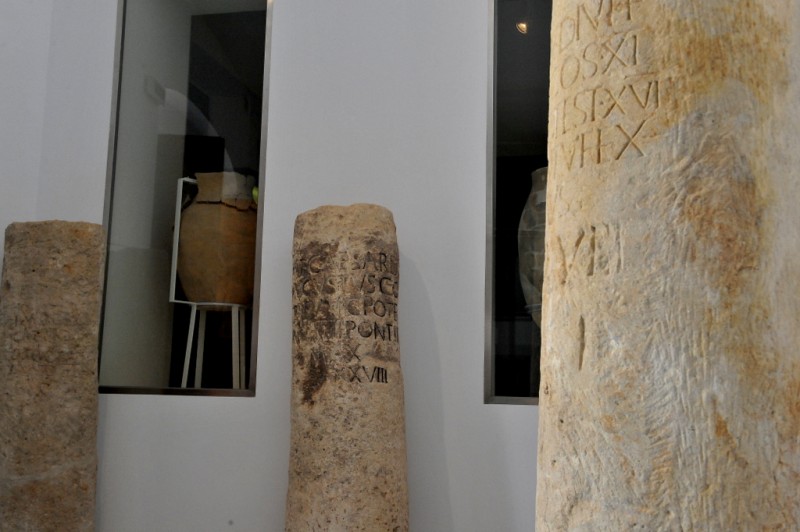
The exhibits
As is to be expected the exhibits in the archaeological museum are arranged in such a way as to make a visit follow a roughly chronological timeline, beginning in the Paleolithic and ending in the 15th century. But before entering, visitors are treated to the sight of three huge Roman milestones, each measuring around 2 metres in height, which have been found in the countryside of Lorca and which provide evidence of the existence of the Roman town named Eliocroca, which later became Lorca.
One of these is the original of the stone which has been reproduced and incorporated into the structure of the Casa de los Marín Ponce de León on Calle Corredera, and the three stones are on show in the entrance porch of the museum.
On entering the museum itself, the content of the different exhibition rooms is as follows:
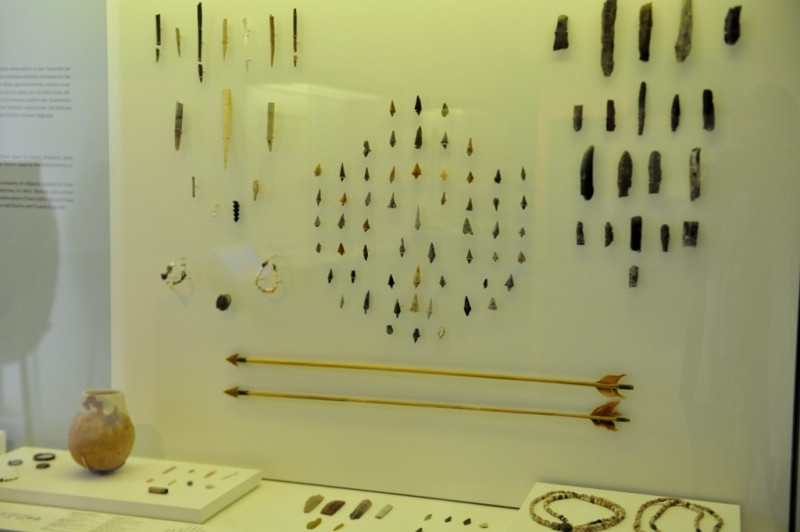
Room 1 – the origins of Lorca
This contains manmade objects dating from between 30,000 and 2,500 years ago, most of them stone tools and weapons. At the start of this long period Man still lived a hunter-gatherer way of life, migrating with the seasons, but eventually the start of agriculture meant that permanent settlements were created, and various of these were in the Guadalentín valley.
Among the items on display here are flint scrapers and arrowheads from the Cerro Negro in Zarcilla de Ramos, a painted idol found in the centre of Lorca and a flint dagger which was unearthed in Calle Juan II in the city centre.

Room 2 – Cueva Sagrada
This room contains the 4,200-year-old woven cloth referred to above, enclosed in a case where the temperature, humidity and light are strictly controlled in order to protect the fragile exhibits. Alongside the fragments, which were found at the Cueva Sagrada burial site and were grave goods, is a reconstruction of the kind of loom, complete with weights, which would have been used to produce them.
One of the unusual aspects of the discovery in Cueva Sagrada is that at the time the cloth was made it was not usual for the dead to be buried in caves, as burial rites normally consisted of stone coffins.
Other items on display include bone needles and a copper and wood punching bradawl, and all came from the same site.
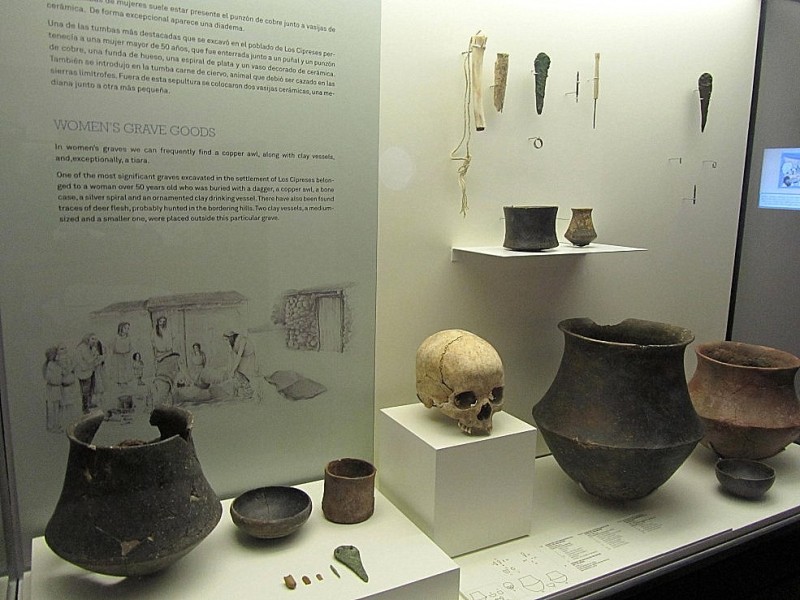
Rooms 3 and 4 – the Argaric culture in Lorca
The Argaric culture was dominant in the south-east of the Iberian Peninsula between roughly 2300 and 1550 BC, and the population built and occupied numerous permanent settlements, most of them on hilltops, in the Region of Murcia and the provinces of Almería, Granada, Alicante and Jaén. This period falls within what is broadly termed the Bronze Age, a stage in technological development which coincides with a revolution in social and urban organization, territorial definition, the emergence of funeral rites and the expansion of the human population.
Only now is evidence being uncovered of Argaric remains in Lorca, and some experts have even theorized that the hill on which the castle stands could have been at the origin of Argaric culture. However, there are various other sites of importance, mainly between Coy and the city of Lorca, among them the one at Los Cipreses, which has been conditioned and can now be visited. On the Cerro de Las Viñas hill two kilometres south of Coy there is another important Argaric site.
Many of the objects exhibited in these two rooms have to do with agriculture, the milling of grain, weaving, ceramics and primitive metallurgy, and there are also various items of jewelry and burial urns and kists. The dead were buried under the floor of their homes in Argaric times, doubled up, dressed, and accompanied by grave goods which typically included weapons, tools and jewelry.
One of the display cases contains the grave goods of an old man who died in Los Cipreses, in the western outskirts of modern Lorca, around 3,900 years ago, including three copper objects and one with an ivory handle.
Moving upstairs (there is also a lift for visitors of limited mobility) …
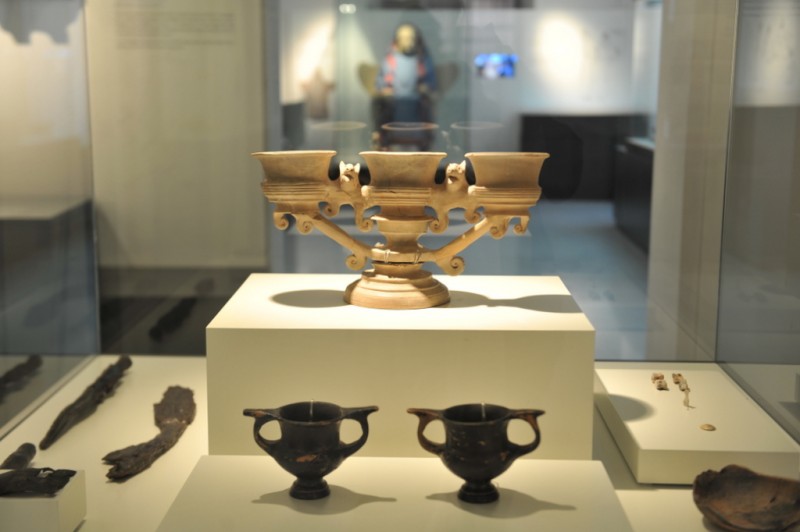
Rooms 5 and 6 – the Iberians in Lorca
The Iberians were a collection of tribes which rose to prominence in much of what is now Spain between approximately the 8th and the 1st centuries BC, gradually absorbing and introducing technological advances which came to them through trading relationships with other civilizations around the Mediterranean.
Among the innovations during their dominance were the first coins to be minted in the Iberian Peninsula, the use of a written alphabet, the introduction of cremation as a funeral rite and different types of ceramic production for different uses: some of these were found in a tomb which was unearthed in Calle Corredera in Lorca in recent years.
Other items on display in this room include various weapons of war (and for hunting), and plenty of evidence to show that horses played an important role in Iberian society.
Perhaps the most eye-catching items, though, are a stone “kernos” (a tray containing three small vessels for offering items to the gods) and the stone carving of a male human head which was found in Calle Carril de Caldereros.
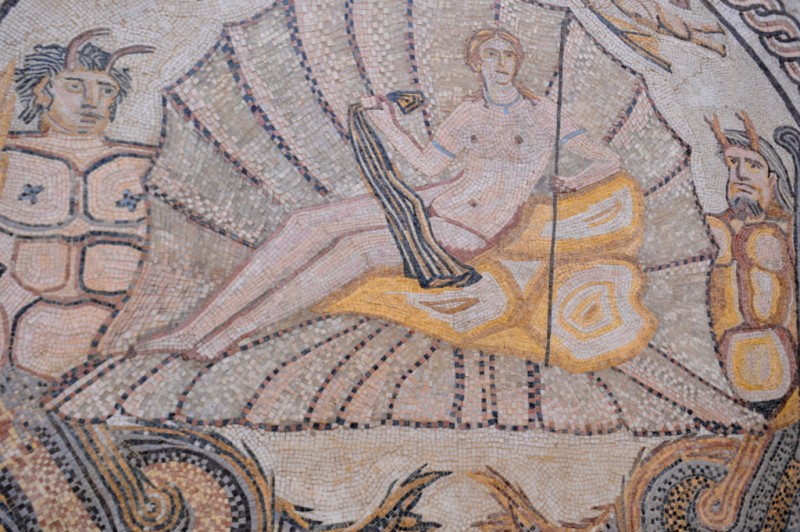
Rooms 7 and 8 - the Romans in Lorca
In Roman times Lorca was known as Eliocroca, and apart from the milestones in the entrance lobby of the archaeological museum plenty of evidence has been found to show that they were present in the area between the 2nd century BC and approximately the 5th AD, engaging in crop and cattle farming as well as trading activity.
Many of these are terra sigillata pieces, including some with decoration which originated not only in Spain but also in France and the north of Africa. There are also numerous items fashioned from ceramics, iron and bronze, many of them associated with the preparation and presentation of food.
Jewels are also present, as are children’s games!
But perhaps the star attractions in the Roman section of the museum are the statue of the god Mercury, which was found in Coy, and the mosaics which were recovered from the farming site of La Quintilla. Both of these sites are within the municipal boundaries of Lorca, and although no monumental forum or theatre has been discovered there can be little doubt that the town was an important trading point on the routes which connected the south-eastern coast with inland Spain.
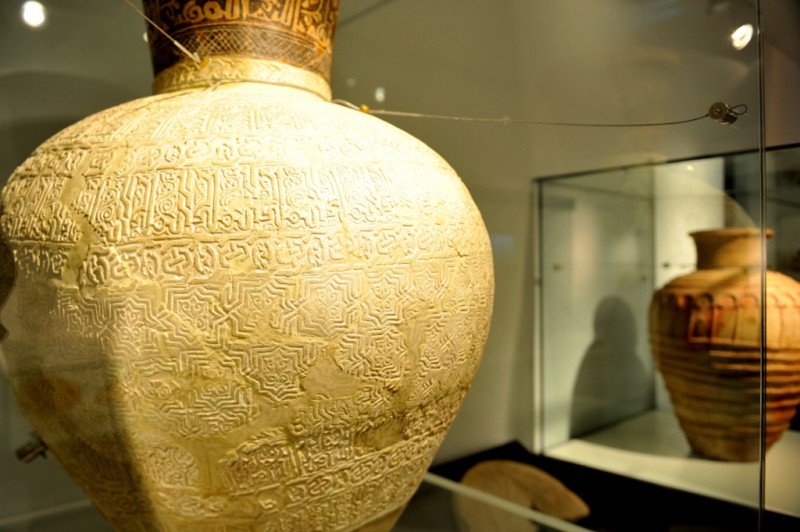
Rooms 9 and 10 – the Moors in Lorca
By the time of the Moorish rule in Spain, which in what is now the Region of Murcia lasted from the 8th to the 13th century, Lorca was established as an important strategic defensive location and, later in the period, a major city with an impressive castle.
At this time the dead were buried, facing Mecca, in narrow graves outside the city walls, and a wide variety of objects belonging to the culture of al-Andalus have been found both here and in other locations in the city. These include elaborately decorated items of ceramics, amulets, talismans, and the artifacts, including stone moulds or casts, which were used in producing and working with different metals.
At the centre of Moorish towns was the mosque, but very few remain in Lorca as they were either destroyed or rebuilt as churches after the Christians conquered the area in 1244. However, one remains at Cortijo del Centeno, and as well as items from this site there are also numerous exhibits shedding light on aspects of daily life such as hygiene, cooking, eating and bringing light into buildings at night.

Room 11 – the Early Middle Ages in Lorca
After the Reconquista of Murcia, Lorca became an important fortified frontier settlement close to the border of the Kingdom of Granada, and this is when the castle and city walls were reinforced to make the city practically impregnable.
In this part of the museum it is possible to see a model showing how Lorca would have looked in the late 13th century, and a reminder of the violence and turbulence of these years is the exhibition of a man’s skull, complete with the head of the crossbow bolt which killed him.
Various other castles existed around Lorca at the time, including those of Tirieza and Xiquena, and they were a vital source of strength to the Christian forces until the Moors were eventually expelled from Granada in 1492.
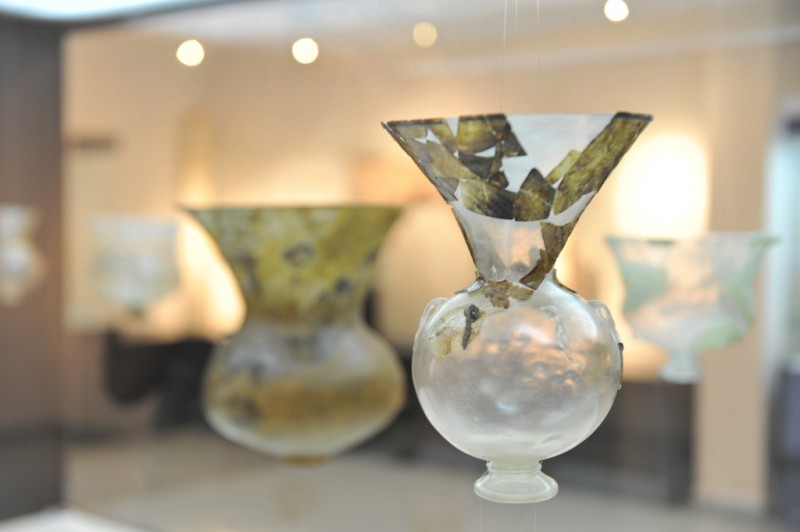
Room 12 – the Jews in medieval Lorca
After 1244 the Moors may have been expelled from Lorca, but Christians and Jews still lived alongside one another in relatively peaceful coexistence, and during the work to build the Parador hotel next to the castle the remains of a 14th century synagogue, the only one so far found in the Region of Murcia, were discovered.
At this site much has been learnt about the Jews in Lorca, and by extension in Murcia, during the Middle Ages, and some of the items on display in this room are unique. The centerpiece is a case containing items of glassware which to the casual observer might appear nothing more than cleverly crafted trinkets, until the fact is brought home by the information panels that they were created 600 years ago.
Some of the jugs, bowls and glasses would not look out of place in a collection of Modernist pieces from the early 20th century, and they show an extraordinary level of skill and craftsmanship. In all over 2,600 fragments of glass were found at the site next to the castle, and it has been possible to reconstruct 27 lamps.
Other items are related to the celebration of Hannukah, and one of the most unusual pieces is a cog wheel which belonged to a musical ratchet, an item which was necessary to drown out the name of the evil Haman during readings of the Book of Esther.
But the contribution of the Jews to the history and culture of Lorca was effectively brought to an end in 1492, when the Catholic Monarchs conquered Granada and expelled them, along with the Moors, from their ever enlarging kingdom. The synagogue of Lorca was never used again, making it the only synagogue site known in Spain to make this claim, and thus rendering it an extremely important location for those of the Jewish faith.
Room 13 – Coin and medal collection
This room contains the numismatic collection assembled by Joaquín Espín Real and donated to the Town Hall by Carmen Ayala Gabarrón in 1992. Included are coins ranging in date from before the birth of Christ to the 20th century, and there are also 117 medals showing the images of kings, popes, princes and emperors.
Finally, on descending the stairs back down to the reception area, visitors see a large wall map of the area in which almost all of the items on display were found. This map shows a large swathe of Spain from the Mediterranean coast as far inland as the province of Albacete.
It is hard to believe for some, but almost all of what is shown on the map, including the wealth of archaeological sites marked on it, either is or was part of Lorca: small wonder, perhaps, that so much archaeological heritage has been unearthed in the municipality!
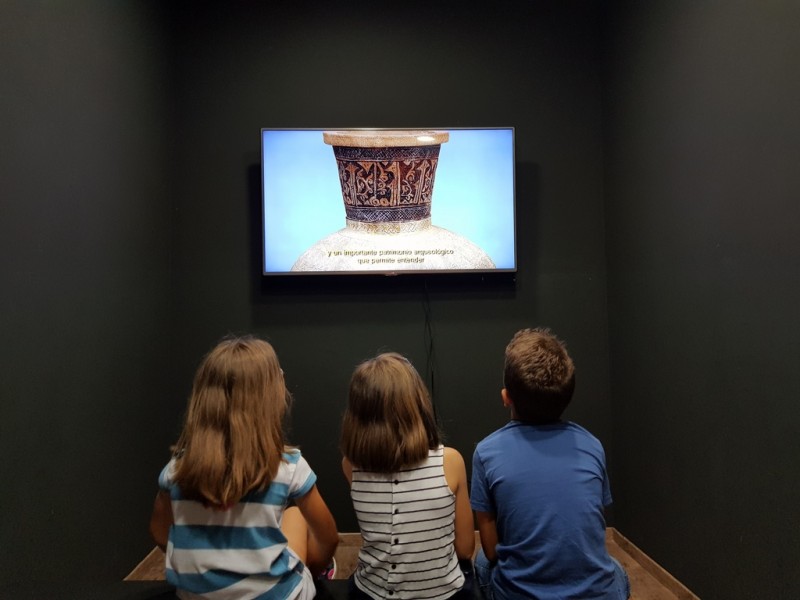
Visiting the Archaeological museum of Lorca
The opening hours of the archeological museum of Lorca are as follows:
Tuesday to Saturday 10.00 to 14.00 and 17.00 to 19.00
Sundays 10.00 to 14.00 only.
Apart from Mondays, the museum remains closed on 25th December and 1st and 6th January.
Group visits can be arranged with prior notice by telephone, and parties of minors must be accompanied by at least one adult per 25 children.
Admission is free of charge.
Those whose grasp of Spanish is shaky will be pleased to take advantage of the fact that the information panels are also presented in English, and the videos shown at various points in the museum have English language subtitles.
Visitors are advised that the following are not permitted:
- Bringing umbrellas or sharp objects into the museum
- Flash photography
- Eating and drinking in the exhibition rooms
- Touching the exhibits
- Leaning on the glass cases
- Bringing pets (other than guide dogs)
In addition, it is requested that mobile phones be switched to silent mode inside the museum.
Location
The museum is alongside Calle Santo Domingo in Plaza Don Juan Moreno, opposite the Casa de los Mula and just a couple of minutes’ walk from the La Merced visitors’ centre where many visitors leave their cars. At this car park visitors can pay exactly 1.45€ into the parking metres - the maximum amount accepted – and the staff inside the centre can then extend the two hours’ parking purchased into an all-day stay by issuing a chit for display in the windscreen.
Address: Museo Arqueológico de Lorca, Plaza de Don Juan Moreno, 30800 Lorca, Murcia
Telephone: 968 406267
Click here to see more articles about the history of Lorca as well as a full cultural agenda and further information about the city: LORCA TODAY
Cartagena
El Carmoli
Islas Menores and Mar de Cristal
La Manga Club
La Manga del Mar Menor
La Puebla
La Torre Golf Resort
La Union
Los Alcazares
Los Belones
Los Nietos
Los Urrutias
Mar Menor Golf Resort
Pilar de la Horadada
Playa Honda / Playa Paraiso
Portman
Roldan and Lo Ferro
San Javier
San Pedro del Pinatar
Santa Rosalia Lake and Life resort
Terrazas de la Torre Golf Resort
Torre Pacheco
Aledo
Alhama de Murcia
Bolnuevo
Camposol
Condado de Alhama
Fuente Alamo
Hacienda del Alamo Golf Resort
Lorca
Mazarron
Puerto de Mazarron
Puerto Lumbreras
Sierra Espuna
Totana
Abaran
Alcantarilla
Archena
Blanca
Corvera
El Valle Golf Resort
Hacienda Riquelme Golf Resort
Lorqui
Molina de Segura
Mosa Trajectum
Murcia City
Peraleja Golf Resort
Ricote
Sucina
Condado de Alhama
El Valle Golf Resort
Hacienda del Alamo Golf Resort
Hacienda Riquelme Golf Resort
Islas Menores and Mar de Cristal
La Manga Club
La Torre Golf Resort
Mar Menor Golf Resort
Mazarron Country Club
Mosa Trajectum
Peraleja Golf Resort
Santa Rosalia Lake and Life resort
Terrazas de la Torre Golf Resort
La Zenia
Lomas de Cabo Roig

CAMPOSOL TODAY Whats OnCartagena SpainCoronavirusCorvera Airport MurciaMurcia Gota Fria 2019Murcia property news generic threadWeekly Bulletin

